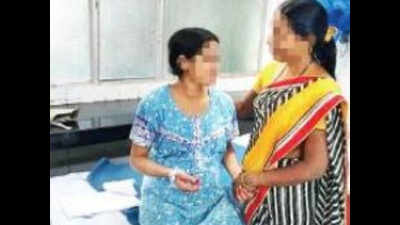- News
- City News
- mumbai News
- Aurangabad model for mothers-to-be helps cut C-sections, painful deliveries
Trending
This story is from December 10, 2018
Aurangabad model for mothers-to-be helps cut C-sections, painful deliveries

The hospital’s model has recently been incorporated in the National Health Mission Guidelines that lists the best practices for centres across the country to follow.
MUMBAI: Numerous studies have found women facing mistreatment and dehumanized care during childbirth at public hospitals, where the blame is often passed on to overcrowding and skewed manpower. Now, Aurangabad’s Government Medical College has demonstrated how despite these challenges a woman can deliver with dignity.
The 210-bed gynaecology unit that handles nearly 18,000 deliveries annually not just brought down obstetric complications, the need to make a vaginal cut, admission rate to neonatal ICU, use of anaesthetic drugs, but even maternal mortality and rate of caesarean sections by adopting simple measures to facilitate the delivery process like inexpensive physical alterations in the labour rooms and allowing a birth companion.The hospital’s model has recently been incorporated in the National Health Mission Guidelines that lists the best practices for centres across the country to follow.

The changes began two years ago with alterations in the labour rooms that so far enabled births mostly in a dorsal position, where the woman is lying on her back with the knees bent up. Dr Shrinivas Gaddapa, who heads the department and is credited with bringing the change, said they fitted the beds with bars that allowed women to try the upright position and counselled mothers-to-be about alternative positions like semi-sitting, squatting and kneeling. In a survey carried out between June and September, the department recorded birthing positions of 2,671 of the 4,071 normal deliveries, and the results were intriguing. While dorsal position remained the most favoured with 1,443 deliveries, 766 women adopted the squatting position. Over 300 women preferred semi-sitting, standing and kneeling, while over 150 delivered in the reclining position. “More crucially, we found that the need to perform an episiotomy (surgical cut at the opening of the vagina) fell drastically as more women chose their comfortable birthing positions,” Dr Gaddapa said. From 80%-90% women who were subjected to episiotomy two years ago, he said, the number has dropped to 30% since the adoption of Respectful Maternity Care practices. “Now, 23% of women who delivered in the dorsal position needed episiotomy, while the number was as low as 7% for those using the upright positions,” added Dr Gadappa, crediting his college dean Dr Kanan Yelikar to allow the amendments.
The 210-bed gynaecology unit that handles nearly 18,000 deliveries annually not just brought down obstetric complications, the need to make a vaginal cut, admission rate to neonatal ICU, use of anaesthetic drugs, but even maternal mortality and rate of caesarean sections by adopting simple measures to facilitate the delivery process like inexpensive physical alterations in the labour rooms and allowing a birth companion.The hospital’s model has recently been incorporated in the National Health Mission Guidelines that lists the best practices for centres across the country to follow.

The changes began two years ago with alterations in the labour rooms that so far enabled births mostly in a dorsal position, where the woman is lying on her back with the knees bent up. Dr Shrinivas Gaddapa, who heads the department and is credited with bringing the change, said they fitted the beds with bars that allowed women to try the upright position and counselled mothers-to-be about alternative positions like semi-sitting, squatting and kneeling. In a survey carried out between June and September, the department recorded birthing positions of 2,671 of the 4,071 normal deliveries, and the results were intriguing. While dorsal position remained the most favoured with 1,443 deliveries, 766 women adopted the squatting position. Over 300 women preferred semi-sitting, standing and kneeling, while over 150 delivered in the reclining position. “More crucially, we found that the need to perform an episiotomy (surgical cut at the opening of the vagina) fell drastically as more women chose their comfortable birthing positions,” Dr Gaddapa said. From 80%-90% women who were subjected to episiotomy two years ago, he said, the number has dropped to 30% since the adoption of Respectful Maternity Care practices. “Now, 23% of women who delivered in the dorsal position needed episiotomy, while the number was as low as 7% for those using the upright positions,” added Dr Gadappa, crediting his college dean Dr Kanan Yelikar to allow the amendments.
The department also allows a birth companion (doula). It emerged that almost every third woman chose to have someone besides her. The hospital also invested in training their doctors and nurses about dealing with patients compassionately. “Women were allowed early initiation of breastfeeding and increased mother-to-child skin contact that helped save many weak newborns,” he said. The hospital also found that auditing of caesarean cases combined with birthing options allowed them to cut C-sections to 27% from 40%. Dr Sanjeev Kamble, head of Directorate of Health Services, said the model was much appreciated during an all-India evaluation of health practices. “More centres should adopt it,” he said. Curiously, it comes at a time when a study of two Mumbai’s public hospitals found rampant disrespect and abuse of pregnant women and systemic problems linked to it.
End of Article
FOLLOW US ON SOCIAL MEDIA










